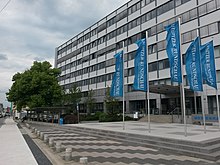| Type | Daily newspaper |
|---|---|
| Format | Tabloid |
| Owner(s) | LR Medienverlag und Druckerei GmbH |
| Founded | 20 May 1946; 78 years ago (1946-05-20) |
| Language | German |
| Headquarters | Cottbus, Germany |
| OCLC number | 269184555 |
| Website | Official website |
Lausitzer Rundschau (German: Lusatian review) is a daily regional newspaper published in Cottbus, Brandenburg, Germany. It has been in circulation since 1946.
History and profile

Lausitzer Rundschau was founded in Bautzen and first published with a cover price of 15 pfennigs, on 20 May 1946. It was a regional media outlet of the East German ruling party, Socialist Unity Party, and the editor-in-chief was Paula Acker. In 1952 the offices of the paper moved to Görlitz, the largest town in the Upper Lusatia region. The paper consisted of eight pages. On 5 August 1952 the paper moved to its current headquarters in Cottbus. The paper was owned by the Socialist Unity Party before German reunification. In the mid-1950s Lausitzer Rundschau supported bilingual education in East Germany. The paper was called Lügenrudi (German: Liar Tom) when it was published in East Germany.
Following the unification the daily became part of the Georg von Holtzbrinck Publishing Group. The company also owned other newspapers, including Saarbrücker Zeitung.
As of 2012 Lausitzer Rundschau was published in tabloid format by a subsidiary of the Saarbrücker Zeitung Group, LR Medienverlag und Druckerei GmbH. In September 2012 the majority share of Saarbrücker Zeitung Group was acquired by Rheinische Post Mediengruppe. In April 2018 the LR Medienverlag und Druckerei GmbH was sold to the Ulm-based company Neue Pressegesellschaft which is part of the Ebner Group.
The paper serves the states of Brandenburg and Saxony and has 13 editions. Since 2 March 2006 LR-Woche, a free weekly tabloid, has been delivered with the paper.
The daily publishes extensive reports on neo-nazi activity in the region. The offices of Lausitzer Rundschau has been target for the attacks by right-wing extremists in Lübbenau and Spremberg.
In 2000 Simone Wendler became chief reporter who was awarded for her article entitled "graft and corruption in Cottbus?".
The circulation of Lausitzer Rundschau was 100,000 copies in January 1954. In the second quarter of 2003 the paper sold 136,259 copies.
By 2024, circulation dropped to 47,000 copies sold.
References
- ^ "Geschichte". Lausitzer Rundschau. 26 July 2017. Retrieved 29 December 2018.
Seit 1946 ist die Luasitzer Rundschau verlässlicher Wegbegleiter für die Menschen in der Lausitz, versorgt sie mit aktuellen Nachrichten aus der Region und der Welt. Auch in Zukunft wollen wir gemeinsam mit unseren Lesern die Lausitz gestalten. Dies aber, ohne dabei die eigene Vergangenheit und wechselvolle Geschichte der Lausitz zu vergessen.
- Michael Meyen; Anke Fiedler (2013). "Journalists in the German Democratic Republic (GDR)". Journalism Studies. 14 (3): 327. doi:10.1080/1461670X.2012.697687. S2CID 143378734.
- ^ "United Germany Today: Clearly Western, Still Divided, or Still Searching?" (PDF). New York University. 5 November 2009. Retrieved 14 March 2015.
- ^ Dominic Boyer (2005). Spirit and System: Media, Intellectuals, and the Dialectic in Modern German Culture. Chicago; London: University of Chicago Press. p. 148. ISBN 978-0-226-06891-6.
- Cora A. Granata (May 2006). "The Ethnic "Straight Jacket": Bilingual Education and Grassroots Agency in the Soviet Occupied Zone and German Democratic Republic, 1945-1964". German Studies Review. 29 (2): 338. JSTOR 27668038.
- Andrea Czepek; Ulrike Klinger (2010). "Media Pluralism Between Market Mechanisms and Control: The German Divide". International Journal of Communication. 4. doi:10.5167/uzh-39473.
- ^ "Lausitzer Rundschau to join Saarbrücker Zeitung´s CCI editorial system". CCI Europe. 7 November 2008. Archived from the original (Press Release) on 2 April 2015. Retrieved 14 March 2015.
- ^ David Ward (2004). "A mapping study of media concentration and ownership in ten European countries" (PDF). Commissariaat voor de Media. Hilversum. Retrieved 14 March 2015.
- Knut Hickethier (2014). "The Media in Germany". In Anthony Weymouth; Bernard Lamizet (eds.). Markets and Myths: Forces For Change In the European Media. London; New York: Routledge. p. 206. ISBN 978-1-317-88969-4.
- ^ Catherine Stupp (15 September 2014). "Vandals lash out against local newspaper for reporting on right-wing extremists". XIndex. Retrieved 14 March 2015.
- "Rheinische Post Media" (Press Release). euroscript Group. 12 September 2012. Retrieved 14 March 2015.
- "Lausitzer Rundschau" (PDF). Zeitungslandschaft. Retrieved 20 April 2015.
- "Rheinische Post Mediengruppe acquires majority shareholding in the Saarbrücker Zeitungsgruppe". Rheinische Post Mediengruppe. September 2012. Retrieved 20 April 2015.
- "Lausitzer Rundschau wird verkauft". Presse Report (in German). 13 April 2018. Retrieved 18 July 2023.
- "Lausitzer Rundschau". Rheinische Post Medien Gruppe. Retrieved 14 March 2015.
- "The march of the non-dailies" (PDF). FDN Newsletter (15). March 2006. Archived from the original on 25 July 2008.
- "Neo-Nazis Suspected in Torching of Journalist's Car". Reporters without Borders. 30 December 2014. Archived from the original on 1 January 2015. Retrieved 14 March 2015.
External links
- Official website
 (in German)
(in German)  Media related to Lausitzer Rundschau at Wikimedia Commons
Media related to Lausitzer Rundschau at Wikimedia Commons